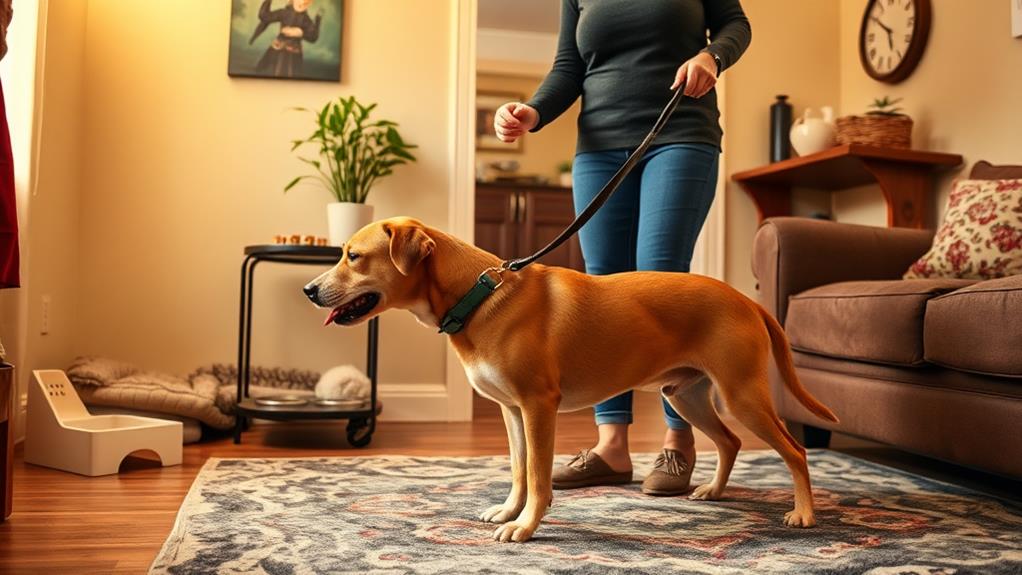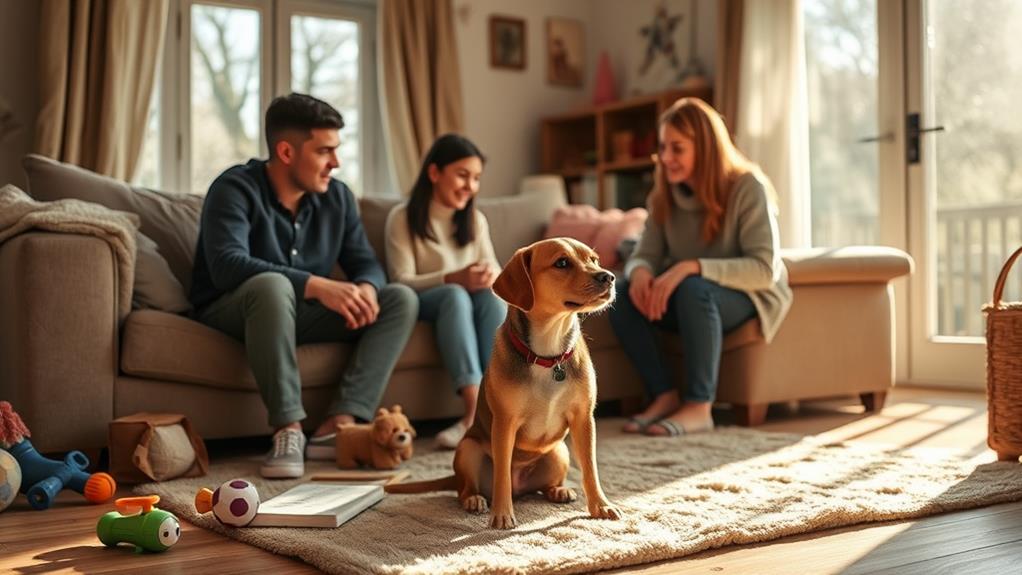Adopting a rescue dog can be an enriching experience, but it comes with challenges. Understanding your dog's unique history is vital. They may show anxiety or fear, especially around new people or situations. Establishing a consistent routine helps them feel secure. Socialize gently to build their confidence and use positive reinforcement to encourage calm behavior. If aggression arises, recognize triggers and provide a safe space for retreat. Patience is key as your dog adjusts. By familiarizing yourself with these techniques, you'll foster a strong bond and mutual trust, placing you on the right path to success. There's more to explore!
Understanding Rescue Dog Behavior

Understanding the unique behaviors of rescue dogs can be a rewarding journey. When you adopt a rescue dog, you're not just bringing home a pet; you're welcoming a new family member with a distinct history. Each dog carries its own experiences, which shapes its personality and behavior. Pay attention to how your dog reacts to different stimuli in its environment, as it might exhibit cautiousness or curiosity.
Many rescue dogs may display certain behaviors rooted in their past. You might notice signs of shyness or wariness around new people or situations. This doesn't mean they're unfriendly; it's simply a reflection of their previous experiences. It's fundamental to give them time and space to adjust to their new home. Establishing a routine can help create a sense of security, allowing your dog to feel more comfortable.
Additionally, building trust is indispensable. Use positive reinforcement techniques, like treats and praise, to encourage desirable behaviors. By understanding and respecting their unique quirks, you'll foster a deeper bond with your rescue dog. Embrace the learning process, and soon you'll see how special your new companion truly is.
Addressing Anxiety and Fear

Many rescue dogs come with a history of anxiety and fear, which can manifest in various ways as they adjust to their new surroundings. You might notice them trembling, hiding, or even barking excessively. Addressing these issues is crucial for building trust and ensuring a smooth changeover into your home.
- Create a Safe Space: Designate a quiet area with their bed, toys, and blankets. This sanctuary allows your dog to retreat when feeling overwhelmed.
- Establish a Routine: Consistency is key. Regular feeding times, walks, and play sessions help your dog feel secure, as they know what to expect throughout the day.
- Use Positive Reinforcement: Reward calm behavior with treats or praise. This encourages your dog to associate their new environment with positive experiences rather than anxiety.
Managing Aggression Issues

Aggression in rescue dogs can often stem from fear or past trauma, making it imperative to address these behaviors effectively. First, observe your dog's body language. Signs like growling, baring teeth, or a stiff posture indicate discomfort. It's essential to identify triggers—people, other dogs, or specific situations—so you can manage encounters safely.
Create a safe space for your dog where they can retreat when feeling overwhelmed. This area should be quiet and free from distractions. When your dog displays aggressive behavior, avoid punishment. Instead, redirect their attention to a toy or treat to shift their focus. Positive reinforcement can work wonders; reward calm behavior with treats or praise.
Establish consistent routines to help your dog feel secure. Predictability can reduce anxiety and aggression. If you're struggling, consider consulting a professional dog trainer or behaviorist experienced with rescue dogs. They can provide tailored strategies to help you and your dog manage aggression effectively.
Socialization Techniques

When bringing a rescue dog into your home, socialization is key to helping them adjust and thrive. Proper socialization can ease anxiety and build confidence, making your new furry friend more comfortable in various situations.
Positive Exposure: Gradually introduce your dog to new experiences, people, and environments. Use treats and praise to create positive associations. Start with less overwhelming situations and increase the complexity as your dog becomes more confident.
Playdates: Arrange playdates with well-behaved dogs. Observing and interacting with other dogs can teach your rescue how to communicate and behave in a pack. Guarantee the dogs are friendly and calm to prevent overwhelming your pup.
Training Classes: Enroll in a basic obedience class or a specialized socialization course. These classes provide structured environments where your dog can learn essential skills while meeting other dogs and people. You'll also gain valuable techniques to reinforce positive behavior.
Establishing a Routine

Establishing a routine is crucial for helping your rescue dog feel secure and settled in their new home. Dogs thrive on predictability, so creating a consistent daily schedule will ease their acclimation. Start by setting regular times for feeding, walks, play, and bathroom breaks. This consistency helps your dog understand what to expect throughout the day.
In the beginning, keep your routine simple. Choose early morning and evening times for meals and walks, as dogs often feel more comfortable with a structured start and end to their day. Stick to these times as closely as possible, even on weekends.
Incorporate training sessions into your routine, but keep them short and engaging. This not only reinforces good behavior but also strengthens your bond. Additionally, allocate time for quiet moments, allowing your dog to relax and adjust to their new environment.
Lastly, be patient. It might take a while for your rescue dog to fully adapt. By maintaining a stable routine, you'll help them feel more confident and secure, paving the way for a happy and harmonious life together.
Encouraging Positive Reinforcement

Positive reinforcement is essential for fostering good behavior in your rescue dog, as it encourages them to repeat actions that earn rewards. By using this method, you can build a trusting relationship and help your dog feel secure in their new environment.
Here are three effective ways to implement positive reinforcement:
- Immediate Rewards: Always reward your dog right after they display the desired behavior. This helps them make the connection between the action and the reward, whether it's a treat, praise, or playtime.
- Consistency is Key: Be consistent with your rewards. If you reward a behavior one day but ignore it the next, it can confuse your dog. Stick to a routine, so your dog knows what to expect.
- Gradual Increase in Challenges: Start with simple commands and gradually increase the difficulty. As your dog masters new skills, continue to reward their progress. This not only keeps them engaged but also helps them build confidence.
Frequently Asked Questions
What Supplies Do I Need Before Bringing Home a Rescue Dog?
Before bringing home a rescue dog, you'll need essentials like food and water bowls, high-quality dog food, a comfortable bed, toys, a leash, collar, ID tags, and grooming supplies. Prepare for a seamless integration!
How Can I Choose the Right Rescue Dog for My Lifestyle?
To choose the right rescue dog for your lifestyle, assess your activity level, space, and time. Visit shelters, interact with dogs, and consider their temperament. Trust your instincts to find a perfect match for you.
What Should I Expect During the First Few Days With a Rescue Dog?
In the first few days with your rescue dog, expect a mix of excitement and uncertainty. You'll bond, establish routines, and face challenges. Patience's key, and remember, it's a journey, not a race.
How Do I Introduce My Rescue Dog to Other Pets?
Introduce your rescue dog to other pets gradually. Start with short, supervised meetings in neutral spaces. Observe their body language, and reward positive interactions. Keep things calm and patient, ensuring both sides feel secure and respected.
Are There Any Specific Training Programs for Rescue Dogs?
You might wonder if specific training programs exist for rescue dogs. Yes, they do! Look for programs tailored to their unique needs, focusing on basic obedience, socialization, or even specialized skills to help your dog thrive.
Conclusion
Adopting a rescue dog can be a rewarding journey, despite the challenges you might face. Remember, "Rome wasn't built in a day." With patience and commitment, you can transform your new furry friend into a loving companion. By understanding their behavior, addressing fears, and establishing routines, you'll create a harmonious bond. Embrace the ups and downs, and soon enough, both you and your rescue dog will flourish together, finding joy in every wag and bark.



